Cutting Niches in Rock Salt by Means of a High-Pressure Water Jet in Order to Accelerate the Leaching of Storage Caverns for Hydrogen or Hydrocarbons
Abstract
1. Introduction
2. Salt Deposits, Borehole Leaching, and Brine Production in Poland
- Central Poland and adjacent areas to the north and northwest with salt dumps; Zechstein salts occur here at a depth of less than 1000 m only in the form of salt dumps, breaking through completely or partially through the Mesozoic overburden;
- Fore-Sudetic area with salt seams, extending in the direction of NW–SE from the area of new salt, through hawthorn and further towards SE;
- The Baltic area with salt deposits, from Łeba in the west to the Gdańsk Bay in the east.
3. Underground Storage Facilities in Leaching Salt Caverns
4. Salt Caver Leaching Technology
- Expected final dimensions,
- Geological structure of the deposit and type of salt rocks within the cavern,
- Accepted leaching technology.
4.1. Shape, Rock Properties, and Cavern Stability
4.2. Salt Leaching Rate
- The average speed of lateral leaching of the vertical wall of the salt rock mass, with clean water at a temperature of 20 °C, is within 8–12 mm/h.
- The rate of floor leaching can vary more than the speed of side leaching—the ratio of floor to side leaching can vary between 1.2 and 3.
- There are no significant differences between the average leaching rates for individual deposits in the world.
- Shortening of the total cavern production time.
- Obtaining higher concentration brine.
- Limited freshwater intake.
- Reduction of energy consumption in the technological process.
- Decrease in demand for storage capacities for non-industrial brine.
5. Experimental Cutting of Samples with a High-Pressure Water Jet
5.1. Petrographic Characterization of Salt Samples
5.1.1. Green Salt
5.1.2. Spiza Salt (Bronze Salt)
5.1.3. Pink Salt
6. Discussion
6.1. The Speed of Cutting the Nozzle in Salt Samples
6.2. Impact of Nozzle Distance on the Amount of Niche Depth Increase
6.3. Changing the Cutting Effect Due to the Flow of the Water Jet on the Samples Placed Below Water Level
6.4. Influence of Rock Type on the Cutting Effect
7. Conclusions
- a
- Rock type—based on comparative tests carried out on samples radically different from salt samples, i.e., granite and sandstone, diversified both petrographically and geomechanically, the strong relationship between rock properties and niche cutting efficiency was confirmed. Salt susceptibility in this range is several times higher. In rocks of greater strength (sandstone, granite), the width of the cut niche was similar to the diameter of the nozzle (jet).
- b
- Cutting tool position—the relationship between the distance of the nozzle from the rock surface (the bottom of the niche being cut out) and the increase in the depth of the niche is not clear and within the range of the tested depths it changes within relatively wide limits, which at this stage does not provide grounds for determining the trend.
- c
- Cutting rate—the speed of making a niche depends on the type of rock salt and can vary from 30% to even 80%. In salt rocks, the width of the obtained niche gradually increased with the time of conducting the experiment. At the end of the test cycle, it was 5 to about 35 times larger than the nozzle diameter, reaching 35 mm.
- d
- Jet flow environment—the result of cutting out a niche with a high-pressure jet passing entirely through the water, located between the surface of the tested sample and the nozzle, is much more diverse compared to the situation when the jet flows in the air. In addition to the main water jet effect, with given flow parameters, intensive expansion of the niche results from the effect of the reflected water jets.
- e
- Leaching technology—it should be assumed that in technical conditions, a high-pressure water jet flowing in the water environment, or rather brine of increasing concentration due to the ongoing leaching process, may weaken the final cutting effect. Salt cutting, in contrast to stronger rocks, is additionally accompanied by a process of dissolution, as well as the removal of larger grains of structural samples.
- (a)
- Depending on the particular type of salt, it may happen that the solid particles (salt, anhydrite, etc.) that are removed by the jet will assist in cutting out the niche. The cut niche in the technical borehole creates extra contact surfaces of water and rock, which in turn may significantly accelerate the industrial leaching process.
Author Contributions
Funding
Conflicts of Interest
References
- Tarkowski, R. Some aspects of underground hydrogen storage. Geol. Rev. 2017, 65, 282–291. [Google Scholar]
- Chromik, M.; Korzeniowski, W. Supporting method for salt caverns leaching—Initial computer simulations. In Proceedings of the XXIV International Salt Symposium ‘Quo Vadis Sal’, Salt Caverns as Components of Pro-Ecological Energy Policy, Żnin, Poland, 9–11 October 2019; Jaworska, J., Nowińska, J., Eds.; Polish Salt Mining Association: Kraków, Poland, 2019; pp. 28–29. [Google Scholar]
- Kunstman, A.; Poborska-Młynarska, K.; Urbańczyk, K. Solution Mining in Salt Deposits. Outline of Recent Development Trends; AGH University of Science and Technology: Kraków, Poland, 2007; p. 20. [Google Scholar]
- Urbańczyk, K. Sources of our knowledge about leaching process (Salt cavern leaching process p. I). Salt Rev. 2015, 11, 32–43. [Google Scholar]
- Wippich, M.; Kleczar, M.; Wilke, F. Geolological Exploration for Storage Cavern Construction in the Zuidwending Salt Dome, The Netherlands. In Proceedings of the SMRI Fall 2010 Technical Conference, Leipzig, Germany, 3–6 October 2010. [Google Scholar]
- Wanyan, Q.; Ding, G.; Zhao, Y.; Li, K.; Deng, J.; Zheng, Y. Key technologies for salt-cavern underground gas storage construction and evaluation and their application. Nat. Gas Ind. B 2018, 5, 623–630. [Google Scholar] [CrossRef]
- Jinlong, L.; Shi, X.; Yang, C.; Li, Y.; Wang, T.; Ma, H.; Shi, H.; Li, J.; Liu, J. Repair of irregularly shaped salt cavern gas storage by re-leaching under gas blanket. J. Nat. Gas Sci. Eng. 2017, 45, 848–859. [Google Scholar] [CrossRef]
- Zheng, Y.; Zhao, Y.; Ding, G.; Wu, Z.; Lu, S.; Lai, X.; Qiu, X.; Yang, N.; Han, B.; Wang, L. Solution mining technology of enlarging space for thick-sandwich salt cavern storage. Pet. Explor. Dev. 2017, 44, 139–145. [Google Scholar] [CrossRef]
- Song, X.; Li, G.; Yuan, J.; Tian, Z.; Shen, R.; Yuan, G.; Huang, Z. Mechanisms and field test of solution mining by self-resonating cavitating water jets. Pet. Sci. 2010, 7, 385–389. [Google Scholar] [CrossRef]
- Oh, T.-M.; Cho, G.-C. Rock Cutting Depth Model Based on Kinetic Energy of AbrasiveWaterjet. Rock Mech. Rock Eng. 2016, 49, 1059–1072. [Google Scholar] [CrossRef]
- Urbańczyk, K. Physical and mathematical description of leaching process. (Salt cavern leaching process p. II). Salt Rev. 2017, 13, 47–66. [Google Scholar]
- Arab, P.B.; Celestino, T.B. A microscopic study on kerfs in rocks subjected to abrasive waterjet cutting. Wear 2020, 448–449, 203210. [Google Scholar] [CrossRef]
- Gryc, R.; Hlaváč, L.M.; Mikoláš, M.; Šancer, J.; Daněk, T. Correlation of pure and abrasive water jet cutting of rocks. Int. J. Rock Mech. Min. Sci. 2014, 65, 149–152. [Google Scholar] [CrossRef]
- Kim, J.-G.; Song, J.-J. Abrasive water jet cutting methods for reducing blast-induced ground vibration in tunnel excavation. Int. J. Rock Mech. Min. Sci. 2015, 75, 147–158. [Google Scholar] [CrossRef]
- Oh, T.-M.; Joo, G.-W.; Cho, G.-C. Effect of Abrasive Feed Rate on Rock Cutting Performance of Abrasive Waterjet. Rock Mech. Rock Eng. 2019, 52, 3431–3442. [Google Scholar] [CrossRef]
- Pierri, L.C.; Pacheco dos Santos, R.; José dos Passos, J., Jr.; Pains, A.M.; Noronha, M.A.M. High pressure abrasive water jet for excavation purpose: A tridimensional approach for cutting strategy. REM Int. Eng. J. 2019, 72, 25–230. [Google Scholar] [CrossRef]
- Song, D.; Wang, E.; Li, Z.; Zhao, E.; Xu, W. An EMR-based method for evaluating the effect of water jet cutting on pressure relief. Arab. J. Geosci. 2015, 8, 4555–4564. [Google Scholar] [CrossRef]
- Song, D.; Wang, E.; Liua, Z.; Liu, X.; Shen, R. Numerical simulation of rock-burst relief and prevention by water-jet cutting. Int. J. Rock Mech. Min. Sci. 2014, 70, 318–331. [Google Scholar] [CrossRef]
- Averin, E. Universal Method for the Prediction of Abrasive Waterjet Performance in Mining. Engineering 2017, 3, 888–891. [Google Scholar] [CrossRef]
- Liu, Z.H.; Du, C.L.; Zheng, Y.L.; Zhang, Q.B.; Zhao, J. Effects of nozzle position and waterjet pressure on rock-breaking performance of roadheader. Tunn. Undergr. Space Technol. 2017, 69, 18–27. [Google Scholar] [CrossRef]
- Gauert, C.D.K.; Van der Westhuizen, W.A.; Claasen, J.O.; Viljoen, S.; Grobler, J. A progress report on ultra-high-pressure waterjet cutting underground: The future of narrow reef gold and PGE mining. J. S. Afr. Inst. Min. Metall. 2013, 113, 441–448. [Google Scholar]
- Korzeniowski, W.; Chromik, M. The method of cavern leaching, especially in the rock salt deposit. Patent Application, no: P.427305. Pat. Off. Bull. 2019, 14, 34. [Google Scholar]
- Polish Geological Institute. National Research Institute. Available online: https://www.pgi.gov.pl/en (accessed on 12 March 2020).
- Salt Caverns Can Be Used as Hydrogen Storage. Available online: https://www.energetyka24.com (accessed on 12 March 2020).
- Gas Storage Poland sp. z o.o. PGNiG S.A. Available online: https://ipi.gasstoragepoland.pl/pl/menu/#mapa-strony (accessed on 18 March 2020).
- Solino Orlen Group. Available online: https://www.solino.pl/PL (accessed on 18 March 2020).
- Burliga, S.; Czapowski, G.; Misiek, G.; Poborska-Młynarska, K.; Garlicki, A. Możliwości Utrzymania Produkcji w Kopalni Soli “Kłodawa” oraz Koncepcji jej Likwidacji w Świetle Obecnego Rozpoznania Budowy Geologicznej, Zagrożeń Naturalnych i Geomechanicznych Skutków Wieloletniej Eksploatacji. Etap I. Aktualizacja Budowy Geologicznej Wysadu Solnego w Granicach Obszaru Górniczego Kopalni Soli “Kłodawa” z Wnioskami dla Dalszego jej Funkcjonowania; Fundacja “Nauka i Tradycje Górnicze“, AGH: Kraków, Poland, 2004; unpublished. [Google Scholar]
- Wachowiak, J. Poziomy mineralne w solach cechsztyńskiego wysadu solnego Kłodawa jako narzędzie korelacji litostratygraficznej. Geologia 2010, 36, 367–393. [Google Scholar]
- Poborski, J. Obraz Stosunków Geologicznych w Przekroju Przez Okolice Wieliczki; Studia i Materiały do Dziejów Żup Krakowskich w Polsce; Muzeum Żup Krakowskie: Wieliczka, Poland, 1977; Volume 6. [Google Scholar]
- Garlicki, A. Sedymentacja Soli Mioceńskich w Polsce; Prace Geologiczne/Polska Akademia Nauk. Oddział w Krakowie. Komisja Nauk Geologicznych; Zakład Narodowy im. Ossolińskich Wydawnictwo PAN: Wrocław/Warszawa, Poland, 1979; p. 119. ISSN 0079-3361. [Google Scholar]
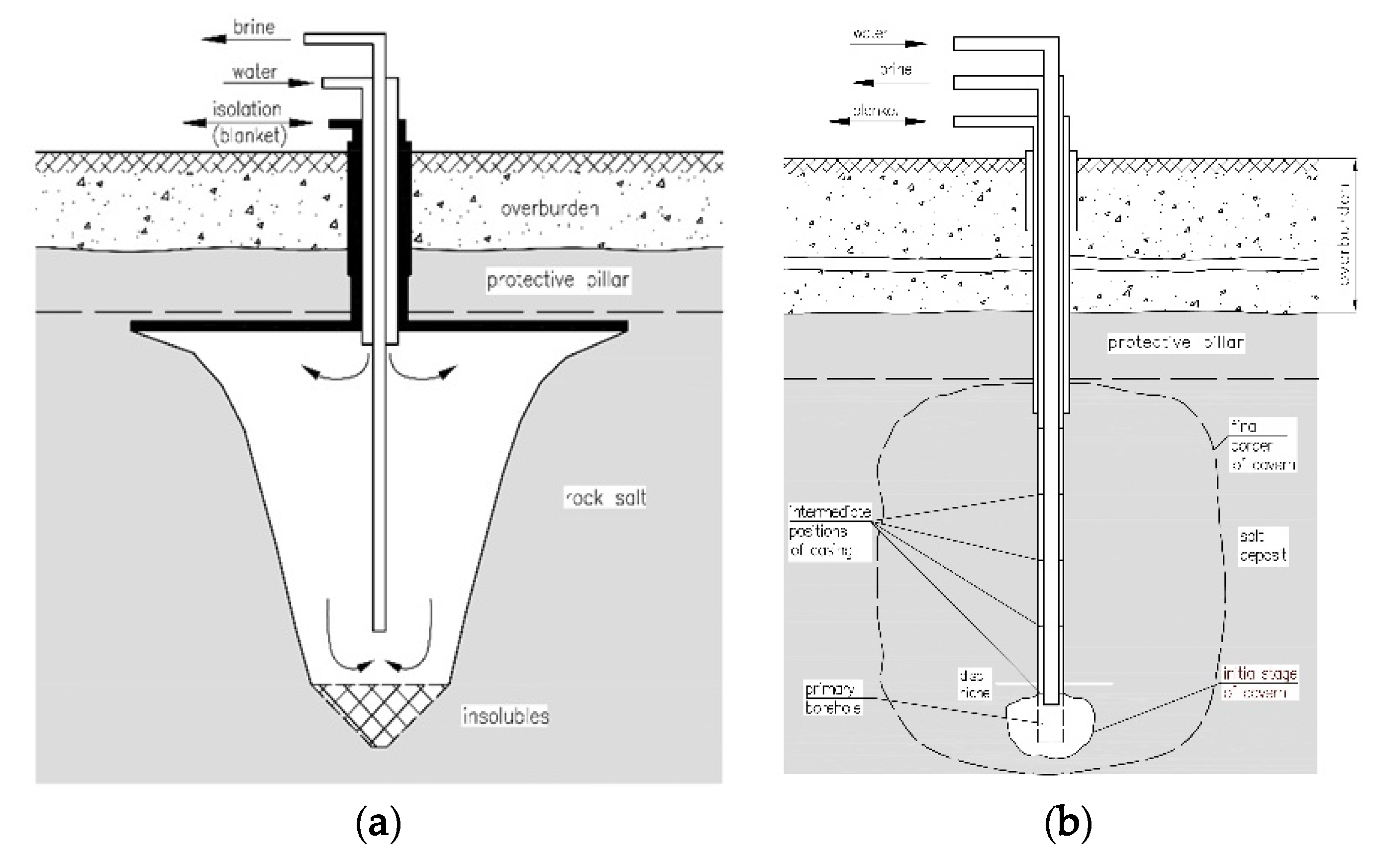

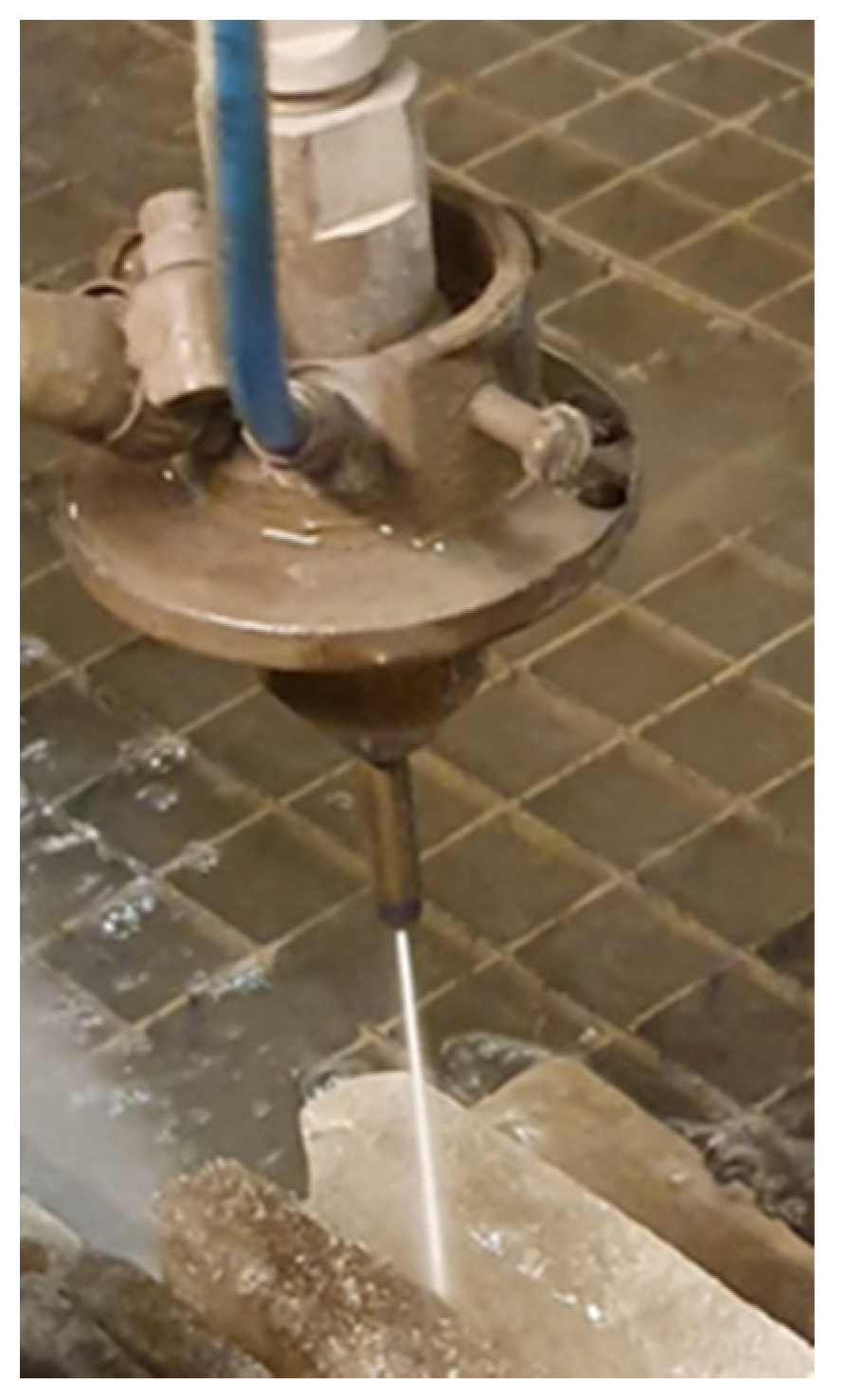

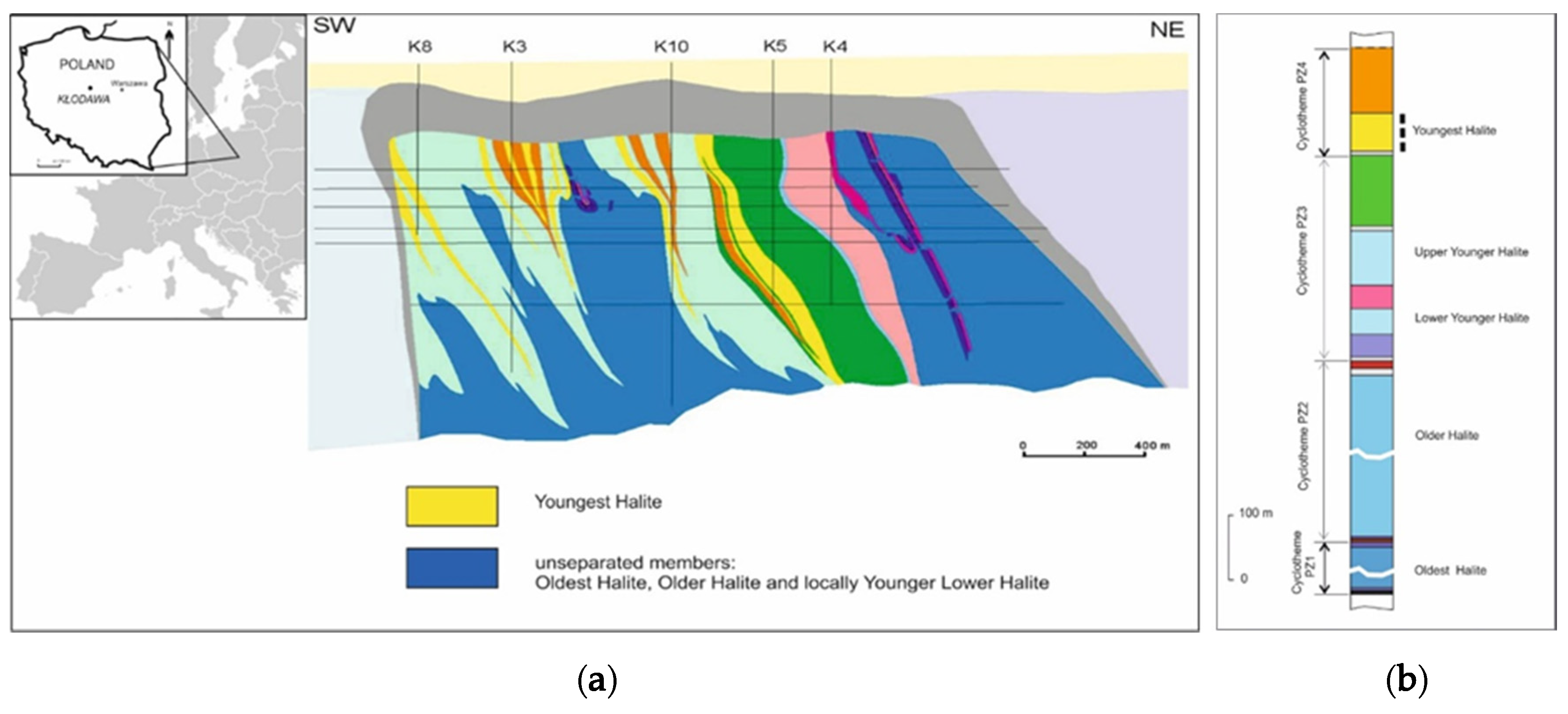
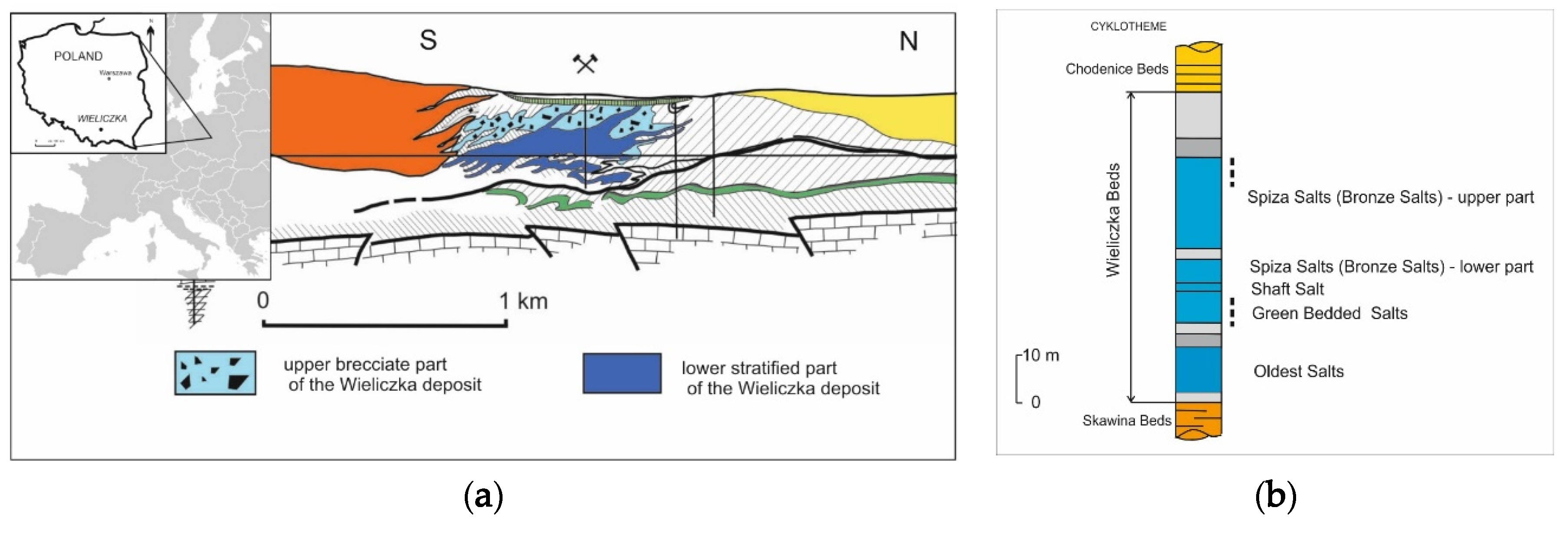
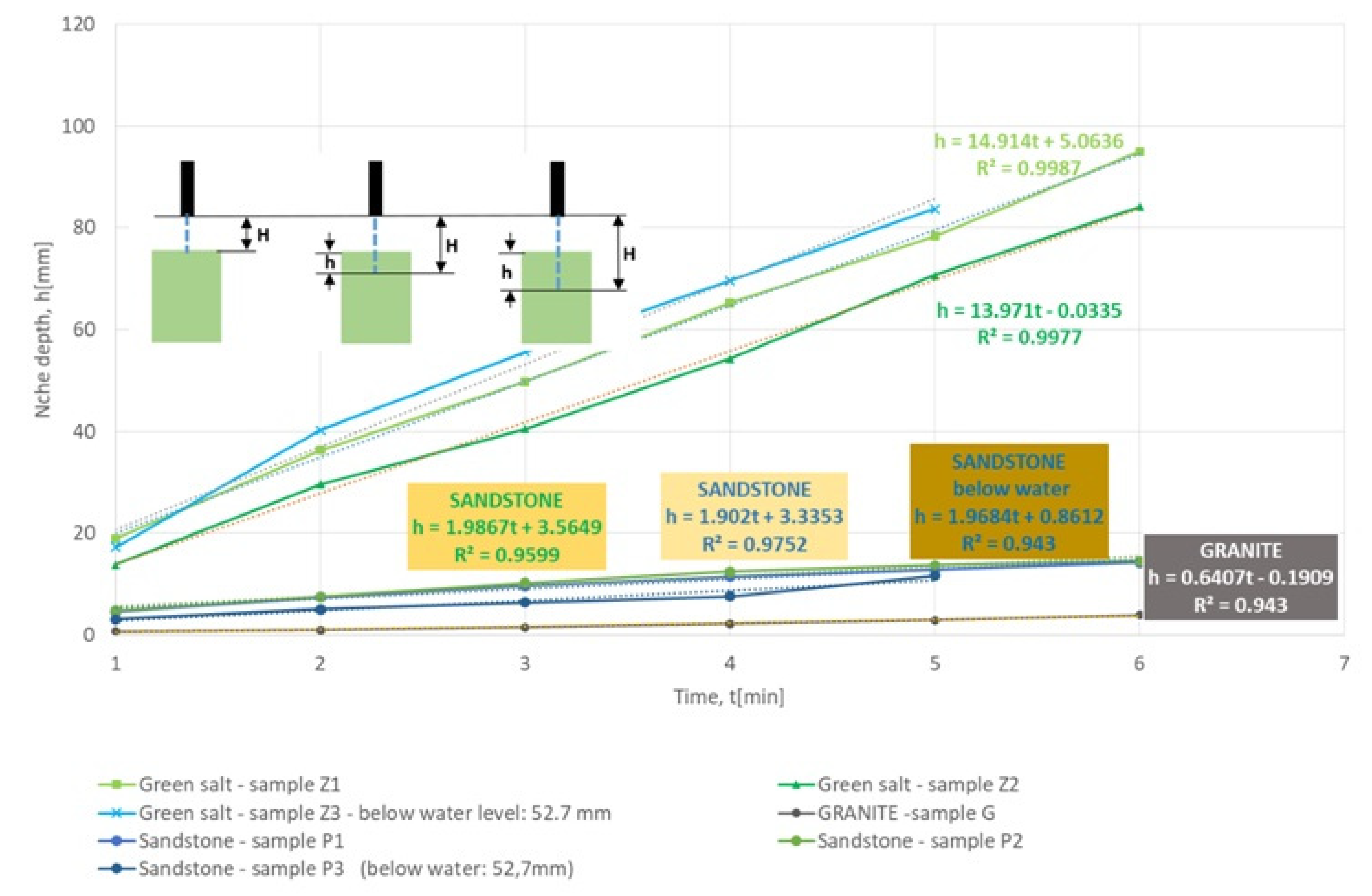
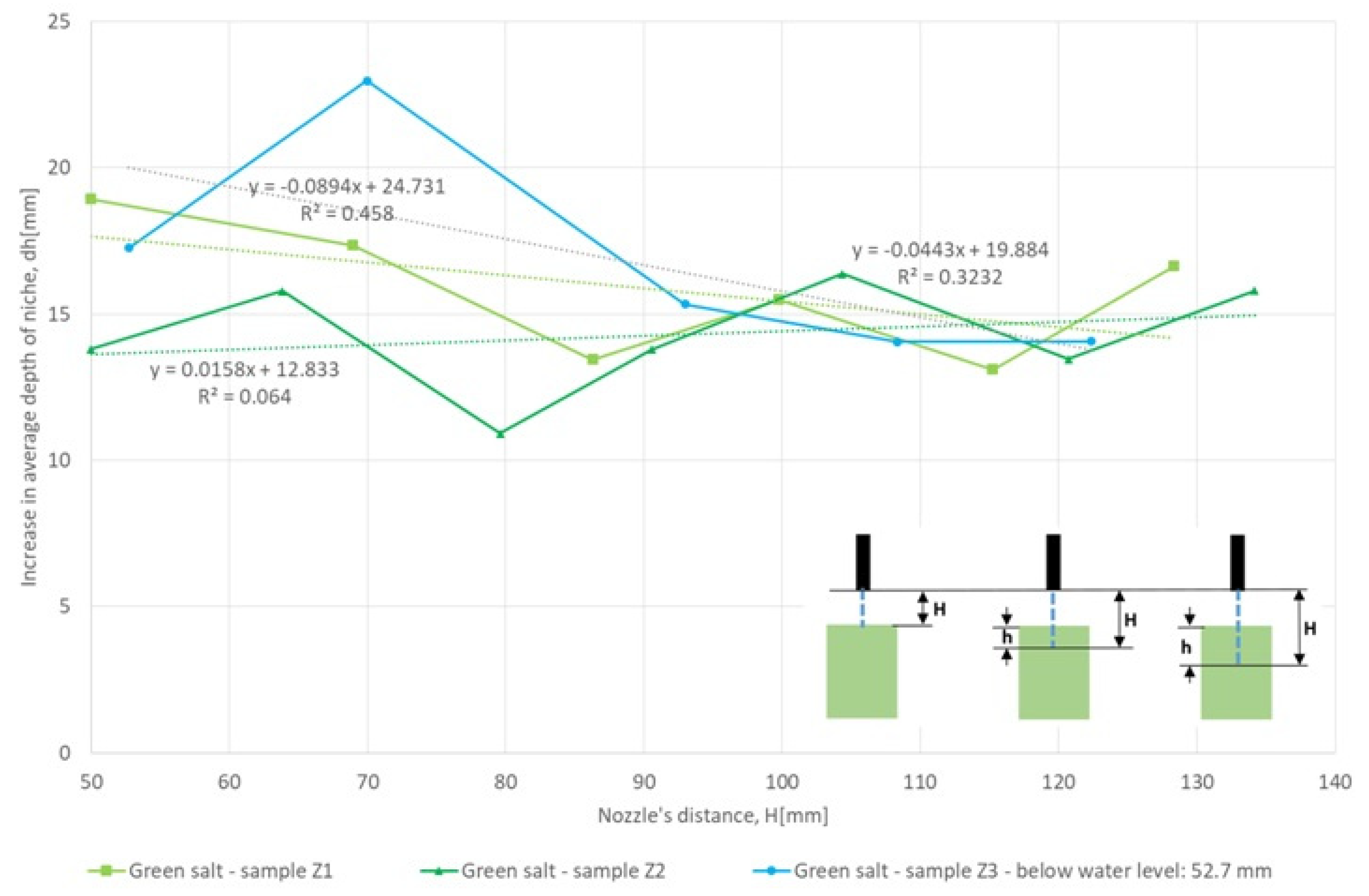
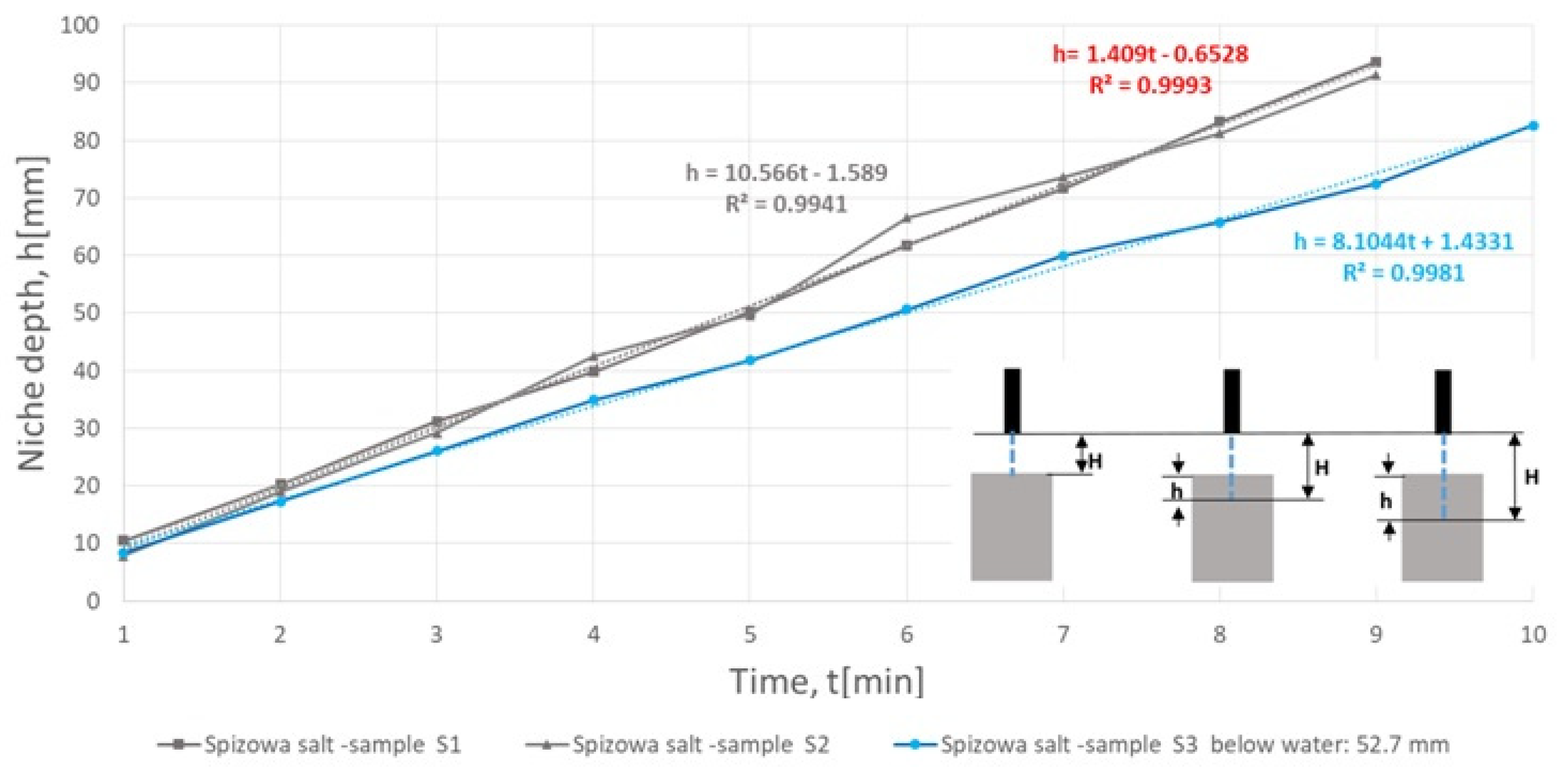
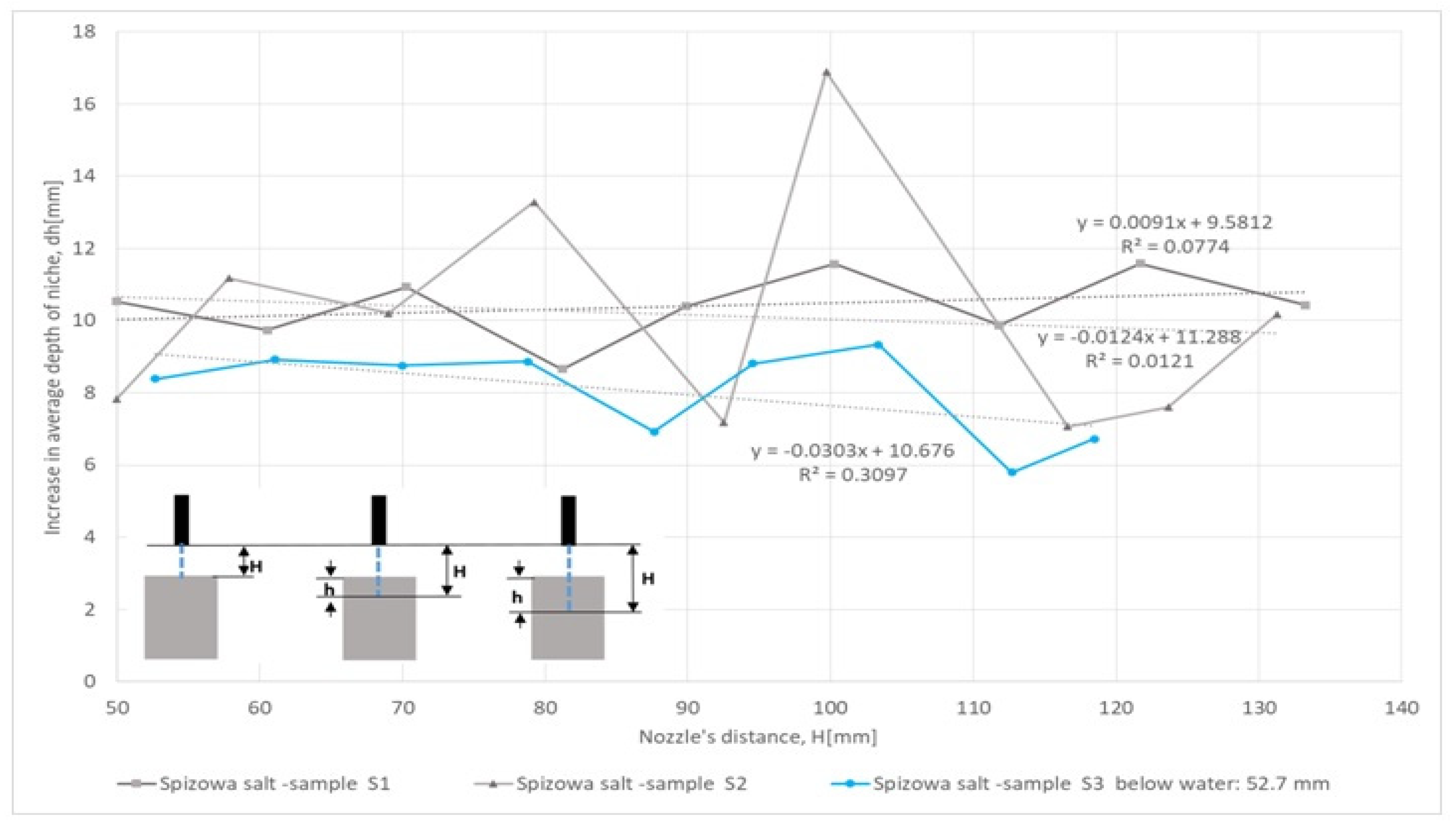
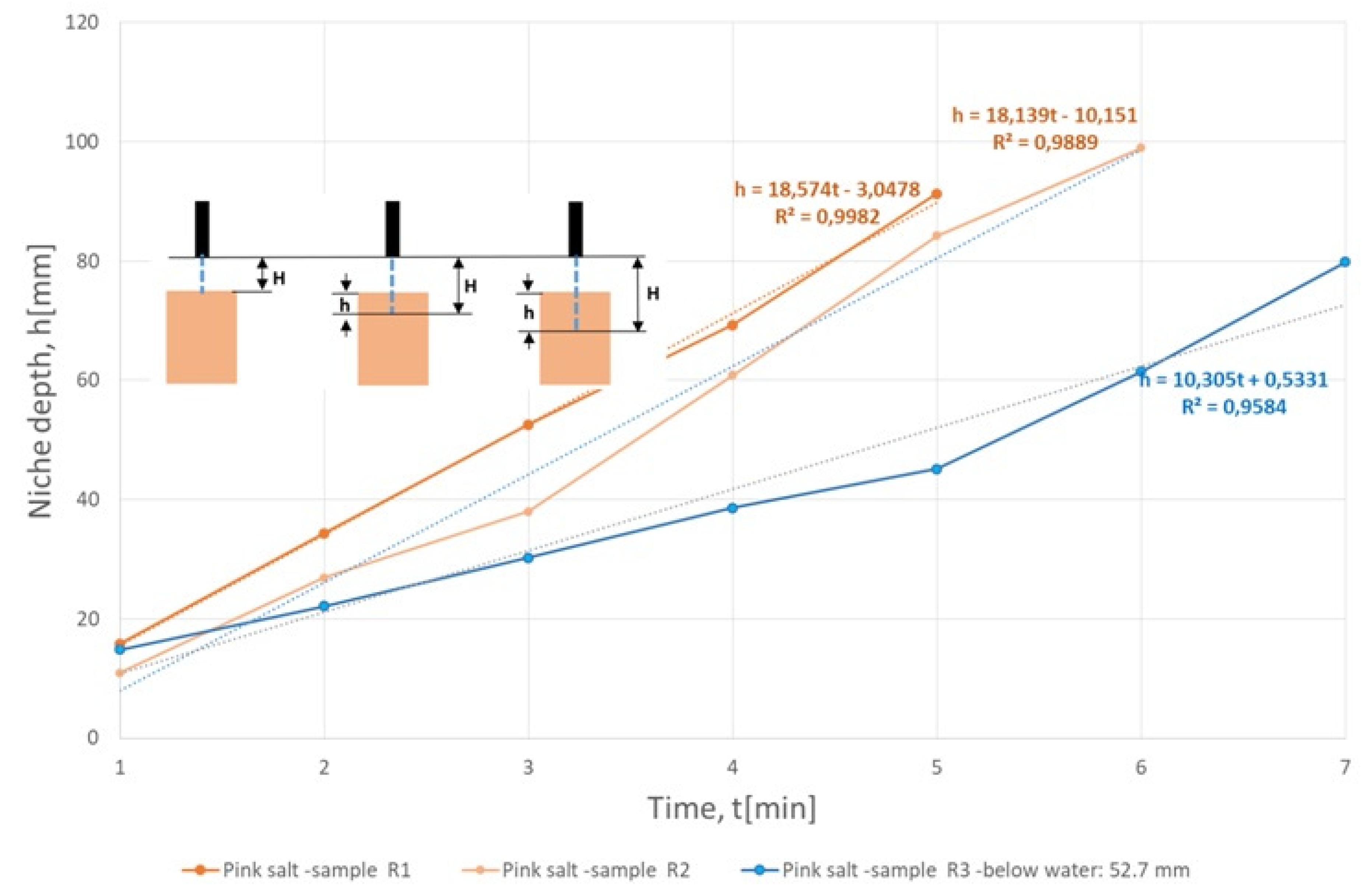
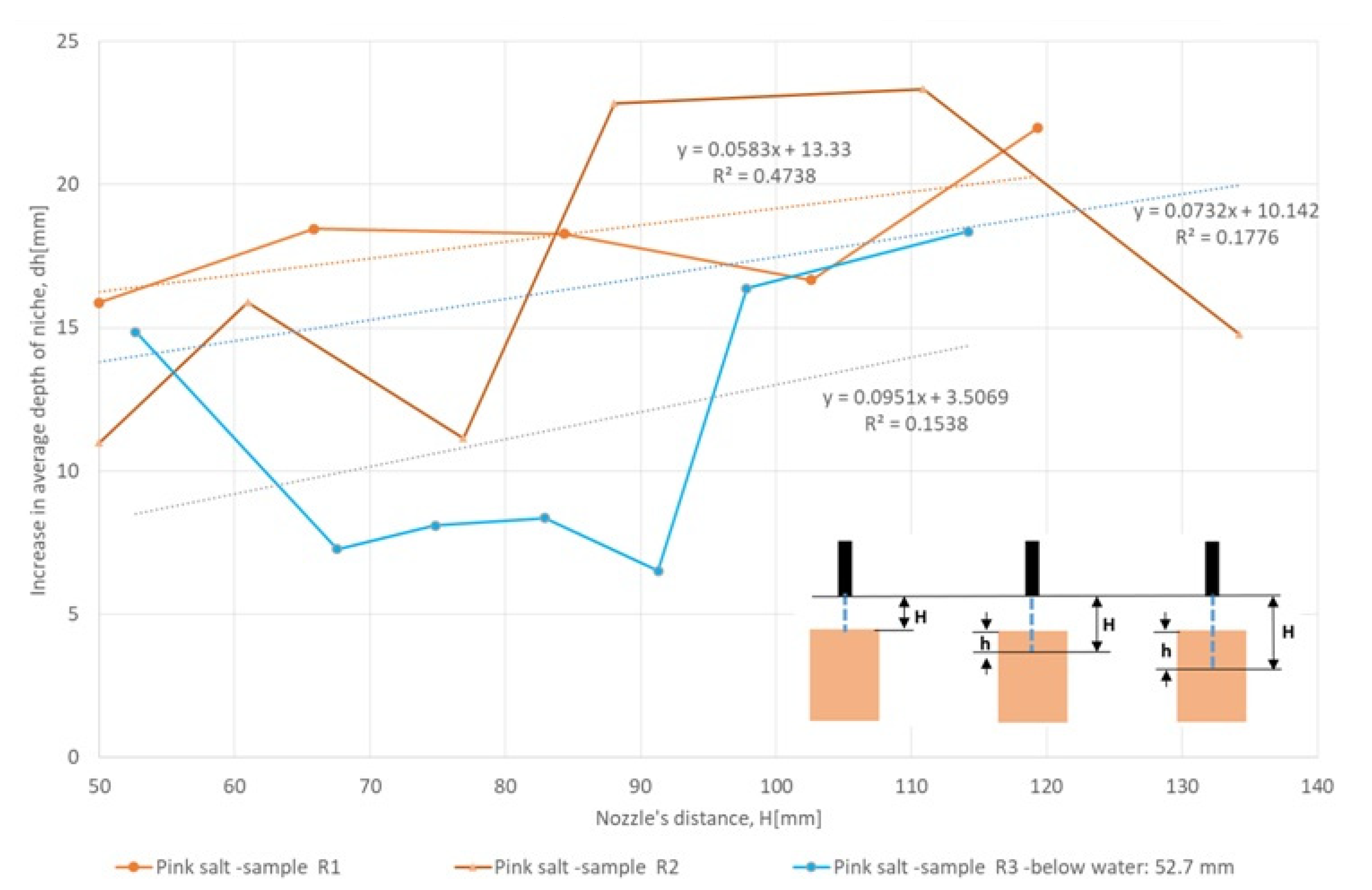
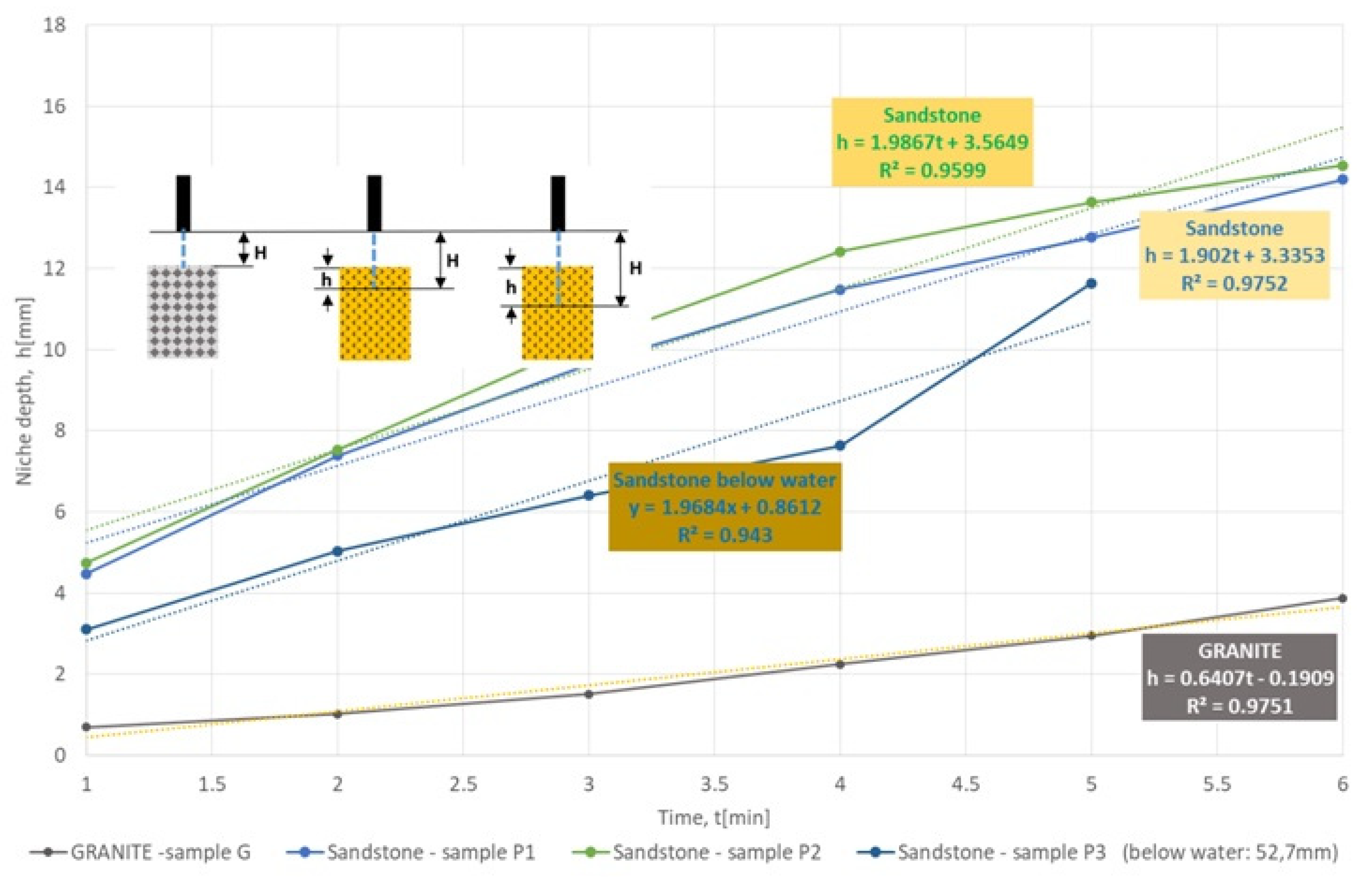
| Mine/Deposit | Salt Yield in Brine, in Thousand Tons | Contribution in the National Production (%) | ||||||||
|---|---|---|---|---|---|---|---|---|---|---|
| Year | Year | |||||||||
| 2014 | 2015 | 2016 | 2017 | 2018 | 2014 | 2015 | 2016 | 2017 | 2018 | |
| Góra and Mogilno I | 2950 | 2706 | 3125 | 3243 | 2817 | 70.4 | 78.03 | 76.6 | 69.6 | 68.3 |
| Mechelinki | 469 | 256 | 474 | 609 | 432 | 11.2 | 7.4 | 11.6 | 13.1 | 10.5 |
| Salt Deposit | Enterprise | Stored Product | Storage Capacity (mln m3) |
|---|---|---|---|
| Mogilno II, salt dome | KPMG Mogilno | Natural gas | 585.40 |
| Góra, salt dome | PMRiP Góra | Crude oil | 4.250 |
| Petroleum Heating oil | 1.880 | ||
| Mechelinki, salt seam | KPMG Kosakowo | Natural gas | 239.40 |
| Green Salt—Sample Z1 | |||||||||
| Cycle time, t(min) | Nozzle-rock surface distance, H(mm) | Local depth of niche, hi (mm) | Average depth, h (mm) | Average depth increase rate, Vh (mm/min) | Average depth increase of niche in a cycle, dh (mm) | ||||
| Current measuring position, xi (mm) | |||||||||
| 0 | 25 | 50 | 75 | 100 | |||||
| 1 | 2 | 3 | 4 | 5 | 6 | 7 | 8 | 9 | 10 |
| 1 | 50.00 | 22.70 | 19.58 | 13.15 | 21.78 | 17.48 | 18.94 | 14.90 | 18.94 |
| 2 | 68.94 | 39.47 | 36.89 | 32.24 | 37.95 | 34.92 | 36.29 | 17.36 | |
| 3 | 86.29 | 54.65 | 44.95 | 51.86 | 51.15 | 46.12 | 49.75 | 13.45 | |
| 4 | 99.75 | 66.19 | 70.01 | 63.28 | 67.00 | 59.72 | 65.24 | 15.49 | |
| 5 | 115.24 | 73.77 | 81.40 | 80.96 | 87.35 | 68.29 | 78.35 | 13.11 | |
| 6 | 128.35 | 92.90 | 100.00 | 100.00 | 95.30 | 86.80 | 95.00 | 16.65 | |
| min: | 13.11 | ||||||||
| max: | 17.36 | ||||||||
| Green Salt—Sample Z2 | |||||||||
| Cycle time, t(min) | Nozzle-rock surface distance, H(mm) | Local depth of niche, hi (mm) | Average depth, h (mm) | Average depth increase rate, Vh (mm/min) | Average depth increase of niche in a cycle, dh (mm) | ||||
| Current measuring position, xi (mm) | |||||||||
| 0 | 25 | 50 | 75 | 100 | |||||
| 1 | 2 | 3 | 4 | 5 | 6 | 7 | 8 | 9 | 10 |
| 1 | 50.00 | 12.57 | 13.87 | 15.04 | 14.32 | 13.26 | 13.81 | 13.97 | 13.81 |
| 2 | 63.81 | 28.18 | 32.26 | 32.15 | 26.18 | 29.27 | 29.61 | 15.80 | |
| 3 | 79.61 | 42.43 | 45.70 | 43.28 | 36.98 | 34.30 | 40.54 | 10.93 | |
| 4 | 90.54 | 55.72 | 63.53 | 60.84 | 47.64 | 43.96 | 54.34 | 13.80 | |
| 5 | 104.34 | 79.33 | 79.32 | 75.32 | 60.20 | 59.40 | 70.71 | 16.38 | |
| 6 | 120.71 | 93.70 | 92.76 | 90.00 | 72.46 | 72.02 | 84.19 | 13.47 | |
| 7 | 134.19 | 100.00 | 100.00 | 100.00 | 100.00 | 100.00 | 100.00 | 15.81 | |
| min: | 10.93 | ||||||||
| max: | 16.38 | ||||||||
| Green Salt—Sample Z3 (below Water) | |||||||||
| Cycle time, t(min) | Nozzle-rock surface distance, H(mm) | Local depth of niche, hi (mm) | Average depth, h(mm) | Average depth increase rate, Vh (mm/min) | Average depth increase of niche in a cycle, dh (mm) | ||||
| Current measuring position, xi (mm) | |||||||||
| 0 | 25 | 50 | 75 | 100 | |||||
| 1 | 2 | 3 | 4 | 5 | 6 | 7 | 8 | 9 | 10 |
| 1 | 52.70 | 20.62 | 20.65 | 17.23 | 11.64 | 16.22 | 17.27 | 16.23 | 17.27 |
| 2 | 69.97 | 48.60 | 45.90 | 36.80 | 36.20 | 33.80 | 40.26 | 22.99 | |
| 3 | 92.96 | 63.92 | 54.70 | 55.33 | 54.20 | 49.90 | 55.61 | 15.35 | |
| 4 | 108.31 | 72.60 | 76.46 | 73.18 | 64.11 | 61.99 | 69.67 | 14.06 | |
| 5 | 122.37 | 100.00 | 77.70 | 74.00 | 100.00 | 67.00 | 83.74 | 14.07 | |
| min: | 14.06 | ||||||||
| max: | 22.99 | ||||||||
| Spiza Salt—Sample S1 | |||||||||
| Cycle time, t(min) | Nozzle-rock surface distance, H (mm) | Local depth of niche, hi (mm) | Average depth, h (mm) | Average depth increase rate, Vh (mm/min) | Average depth increase of niche in a cycle, dh (mm) | ||||
| Current measuring position, xi (mm) | |||||||||
| 0 | 25 | 50 | 75 | 100 | |||||
| 1 | 2 | 3 | 4 | 5 | 6 | 7 | 8 | 9 | 10 |
| 1 | 50.00 | 11.33 | 9.89 | 9.92 | 12.39 | 9.14 | 10.53 | 10.41 | 10.53 |
| 2 | 60.53 | 18.22 | 19.37 | 20.68 | 22.80 | 20.26 | 20.27 | 9.73 | |
| 3 | 70.27 | 28.60 | 31.40 | 33.68 | 34.71 | 27.60 | 31.20 | 10.93 | |
| 4 | 81.20 | 39.22 | 39.02 | 38.25 | 41.05 | 41.70 | 39.85 | 8.65 | |
| 5 | 89.85 | 51.83 | 50.52 | 52.07 | 50.70 | 46.10 | 50.24 | 10.40 | |
| 6 | 100.24 | 61.22 | 65.09 | 60.04 | 60.20 | 62.50 | 61.81 | 11.57 | |
| 7 | 111.81 | 72.61 | 75.15 | 72.12 | 71.02 | 67.51 | 71.68 | 9.87 | |
| 8 | 121.68 | 82.10 | 85.64 | 81.40 | 84.03 | 83.15 | 83.26 | 11.58 | |
| 9 | 133.26 | 95.67 | 93.98 | 98.37 | 93.41 | 87.02 | 93.69 | 10.43 | |
| min: | 8.65 | ||||||||
| max: | 11.58 | ||||||||
| Spiza Salt—Sample S2 | |||||||||
| Cycle time, t(min) | Nozzle-rock surface distance, H (mm) | Local depth of niche, hi (mm) | Average depth, h (mm) | Average depth increase rate, Vh (mm/min) | Average depth increase of niche in a cycle, dh (mm) | ||||
| Current measuring position, xi (mm) | |||||||||
| 0 | 25 | 50 | 75 | 100 | |||||
| 1 | 2 | 3 | 4 | 5 | 6 | 7 | 8 | 9 | 10 |
| 1 | 50.00 | 9.60 | 9.66 | 7.09 | 7.54 | 5.32 | 7.84 | 10.57 | 7.84 |
| 2 | 57.84 | 21.41 | 19.46 | 21.10 | 18.41 | 14.71 | 19.02 | 11.18 | |
| 3 | 69.02 | 34.06 | 30.38 | 31.80 | 27.70 | 22.15 | 29.22 | 10.20 | |
| 4 | 79.22 | 39.10 | 53.73 | 40.40 | 46.08 | 33.22 | 42.51 | 13.29 | |
| 5 | 92.51 | 54.36 | 56.22 | 51.30 | 47.13 | 39.41 | 49.68 | 7.18 | |
| 6 | 99.68 | 100.00 | 65.20 | 61.10 | 55.66 | 50.95 | 66.58 | 16.90 | |
| 7 | 116.58 | 100.00 | 72.55 | 71.12 | 65.82 | 58.77 | 73.65 | 7.07 | |
| 8 | 123.65 | 100.00 | 81.31 | 80.46 | 77.10 | 67.40 | 81.25 | 7.60 | |
| 9 | 131.25 | 100.00 | 100.00 | 90.58 | 88.75 | 77.78 | 91.42 | 10.17 | |
| min: | 7.07 | ||||||||
| max: | 16.90 | ||||||||
| Spiza Salt—Sample S3 (below Water) | |||||||||
| Cycle time, t(min) | Nozzle-rock surface distance, H(mm) | Local depth of niche, hi (mm) | Average depth, h(mm) | Average depth increase rate, Vh (mm/min) | Average depth increase of niche in a cycle, dh (mm) | ||||
| Current measuring position, xi (mm) | |||||||||
| 0 | 25 | 50 | 75 | 100 | |||||
| 1 | 2 | 3 | 4 | 5 | 6 | 7 | 8 | 9 | 10 |
| 1 | 52.70 | 8.81 | 8.75 | 9.14 | 7.98 | 7.25 | 8.39 | 8.10 | 8.39 |
| 2 | 61.09 | 16.10 | 16.75 | 20.08 | 19.55 | 14.05 | 17.31 | 8.92 | |
| 3 | 70.01 | 25.46 | 26.02 | 28.44 | 33.03 | 17.35 | 26.06 | 8.75 | |
| 4 | 78.76 | 33.08 | 33.45 | 36.55 | 42.33 | 29.20 | 34.92 | 8.86 | |
| 5 | 87.62 | 39.40 | 41.71 | 40.54 | 50.45 | 37.13 | 41.85 | 6.92 | |
| 6 | 94.55 | 49.97 | 48.15 | 50.80 | 59.69 | 44.65 | 50.65 | 8.81 | |
| 7 | 103.35 | 57.23 | 54.95 | 74.25 | 65.01 | 48.47 | 59.98 | 9.33 | |
| 8 | 112.68 | 58.49 | 65.63 | 73.77 | 70.74 | 60.24 | 65.77 | 5.79 | |
| 9 | 118.47 | 61.02 | 73.31 | 82.42 | 80.35 | 65.40 | 72.50 | 6.73 | |
| 10 | 125.20 | 64.30 | 80.39 | 100.00 | 100.00 | 68.52 | 82.64 | 10.14 | |
| min: | 5.79 | ||||||||
| max: | 10.14 | ||||||||
| Pink Salt—Sample R1 | |||||||||
| Cycle time, t(min) | Nozzle-rock surface distance, H(mm) | Local depth of niche, hi (mm) | Average depth, h (mm) | Average depth increase rate, Vh (mm/min) | Average depth increase of niche in a cycle, dh (mm) | ||||
| Current measuring position, xi (mm) | |||||||||
| 0 | 25 | 50 | 75 | 100 | |||||
| 1 | 2 | 3 | 4 | 5 | 6 | 7 | 8 | 9 | 10 |
| 1 | 50.00 | 19.82 | 20.20 | 15.73 | 11.82 | 11.80 | 15.87 | 18.57 | 15.87 |
| 2 | 65.87 | 38.29 | 38.24 | 32.16 | 29.35 | 33.63 | 34.33 | 18.46 | |
| 3 | 84.33 | 58.65 | 57.67 | 49.14 | 46.60 | 50.99 | 52.61 | 18.28 | |
| 4 | 102.61 | 88.84 | 71.41 | 61.76 | 60.11 | 64.32 | 69.29 | 16.68 | |
| 5 | 119.29 | 100.00 | 89.00 | 74.84 | 92.50 | 100.00 | 91.27 | 21.98 | |
| min: | 15.87 | ||||||||
| max: | 21.98 | ||||||||
| Pink Salt—Sample R2 | |||||||||
| Cycle time, t (min) | Nozzle-rock surface distance, H(mm) | Local depth of niche, hi (mm) | Average depth, h (mm) | Average depth increase rate, Vh (mm/min) | Average depth increase of niche in a cycle, dh (mm) | ||||
| Current measuring position, xi (mm) | |||||||||
| 0 | 25 | 50 | 75 | 100 | |||||
| 1 | 2 | 3 | 4 | 5 | 6 | 7 | 8 | 9 | 10 |
| 1 | 50.00 | 17.40 | 11.12 | 8.70 | 11.35 | 6.40 | 10.99 | 18.14 | 10.99 |
| 2 | 60.99 | 31.80 | 21.34 | 30.80 | 31.97 | 18.54 | 26.89 | 15.90 | |
| 3 | 76.89 | 38.98 | 39.65 | 33.82 | 44.81 | 32.90 | 38.03 | 11.14 | |
| 4 | 88.03 | 64.40 | 63.01 | 60.47 | 73.88 | 42.64 | 60.88 | 22.85 | |
| 5 | 110.88 | 84.20 | 85.40 | 100.00 | 89.46 | 62.03 | 84.22 | 23.34 | |
| 6 | 134.22 | 100.00 | 100.00 | 100.00 | 100.00 | 95.00 | 99.00 | 14.78 | |
| min: | 10.99 | ||||||||
| max: | 23.34 | ||||||||
| Pink Salt—Sample R3 (below Water) | |||||||||
| Cycle time, t (min) | Nozzle-rock surface distance, H (mm) | Local depth of niche, hi (mm) | Average depth, h (mm) | Average depth increase rate, Vh (mm/min) | Average depth increase of niche in a cycle, dh (mm) | ||||
| Current measuring position, xi (mm) | |||||||||
| 0 | 25 | 50 | 75 | 100 | |||||
| 1 | 2 | 3 | 4 | 5 | 6 | 7 | 8 | 9 | 10 |
| 1 | 52.70 | 17.60 | 10.53 | 4.50 | 22.60 | 19.07 | 14.86 | 10.30 | 14.86 |
| 2 | 67.56 | 31.30 | 22.25 | 8.25 | 29.62 | 19.27 | 22.14 | 7.28 | |
| 3 | 74.84 | 35.84 | 33.83 | 11.85 | 36.75 | 32.90 | 30.23 | 8.10 | |
| 4 | 82.93 | 44.42 | 37.30 | 12.58 | 53.22 | 45.46 | 38.60 | 8.36 | |
| 5 | 91.30 | 54.77 | 38.28 | 13.08 | 62.30 | 57.15 | 45.12 | 6.52 | |
| 6 | 97.82 | 64.77 | 55.45 | 27.70 | 85.79 | 73.72 | 61.49 | 16.37 | |
| 7 | 114.19 | 79.71 | 79.00 | 58.06 | 94.22 | 88.26 | 79.85 | 18.36 | |
| min: | 6.52 | ||||||||
| max: | 18.36 | ||||||||
| GRANITE—Sample G | |||||||||
| Cycle time, t (min) | Nozzle-rock surface distance, H (mm) | Local depth of niche, hi (mm) | Average depth, h (mm) | Average depth increase rate, Vh (mm/min) | Average depth increase of niche in a cycle, dh (mm) | ||||
| Current measuring position, xi (mm) | |||||||||
| 0 | 25 | 50 | 75 | 100 | |||||
| 1 | 2 | 3 | 4 | 5 | 6 | 7 | 8 | 9 | 10 |
| 1 | 50.00 | 0.08 | 0.13 | 0.82 | 1.39 | 1.08 | 0.70 | 0.64 | 0.70 |
| 2 | 50.70 | 0.12 | 1.15 | 1.27 | 1.40 | 1.15 | 1.02 | 0.32 | |
| 3 | 51.02 | 0.76 | 1.31 | 1.70 | 2.03 | 1.76 | 1.51 | 0.49 | |
| 4 | 51.51 | 1.20 | 1.65 | 1.70 | 2.40 | 4.30 | 2.25 | 0.74 | |
| 5 | 52.25 | 1.51 | 1.75 | 2.70 | 4.30 | 4.51 | 2.95 | 0.70 | |
| 6 | 52.95 | 2.73 | 2.22 | 2.78 | 6.05 | 5.60 | 3.88 | 0.92 | |
| min: | 0.32 | ||||||||
| max: | 0.92 | ||||||||
| Granite—Sample G (below Water: 52.7 mm) | |||||||||
| Cycle time, t (min) | Nozzle-rock surface distance, H (mm) | Local depth of niche, hi (mm) | Average depth, h (mm) | Average depth increase rate, Vh (mm/min) | Average depth increase of niche in a cycle, dh (mm) | ||||
| Current measuring position, xi (mm) | |||||||||
| 0 | 25 | 50 | 75 | 100 | |||||
| 1 | 2 | 3 | 4 | 5 | 6 | 7 | 8 | 9 | 10 |
| 1 | 52.70 | 0.05 | 0.58 | 0.67 | 0.34 | 0.22 | 0.37 | 0.37 | |
| Sandstone—Sample P1 | |||||||||
| Cycle time, t (min) | Nozzle-rock surface distance, H (mm) | Local depth of niche, hi (mm) | Average depth, h (mm) | Average depth increase rate, Vh (mm/min) | Average depth increase of niche in a cycle, dh (mm) | ||||
| Current measuring position, xi (mm) | |||||||||
| 0 | 25 | 50 | 75 | 100 | |||||
| 1 | 2 | 3 | 4 | 5 | 6 | 7 | 8 | 9 | 10 |
| 1 | 50.00 | 3.91 | 4.72 | 4.10 | 4.42 | 5.22 | 4.47 | 1.90 | 4.47 |
| 2 | 54.47 | 6.74 | 7.51 | 6.69 | 8.12 | 7.90 | 7.39 | 2.92 | |
| 3 | 57.39 | 8.96 | 9.42 | 8.88 | 10.79 | 10.18 | 9.65 | 2.25 | |
| 4 | 59.64 | 11.01 | 10.92 | 10.46 | 12.54 | 12.47 | 11.48 | 1.83 | |
| 5 | 61.48 | 11.54 | 12.99 | 11.93 | 13.11 | 14.25 | 12.76 | 1.28 | |
| 6 | 62.76 | 13.20 | 14.92 | 13.26 | 14.27 | 15.34 | 14.20 | 1.43 | |
| min: | 1.28 | ||||||||
| max: | 2.92 | ||||||||
| Sandstone—Sample P2 | |||||||||
| Cycle time, t (min) | Nozzle-rock surface distance, H (mm) | Local depth of niche, hi (mm) | Average depth, h (mm) | Average depth increase rate, Vh (mm/min) | Average depth increase of niche in a cycle, dh (mm) | ||||
| Current measuring position, xi (mm) | |||||||||
| 0 | 25 | 50 | 75 | 100 | |||||
| 1 | 2 | 3 | 4 | 5 | 6 | 7 | 8 | 9 | 10 |
| 1 | 50.00 | 4.32 | 4.08 | 4.65 | 4.90 | 5.75 | 4.74 | 1.99 | 4.74 |
| 2 | 54.74 | 7.26 | 7.11 | 7.43 | 7.14 | 8.74 | 7.54 | 2.80 | |
| 3 | 57.54 | 9.44 | 9.37 | 10.94 | 9.54 | 11.83 | 10.22 | 2.69 | |
| 4 | 60.22 | 11.20 | 11.47 | 13.60 | 12.01 | 13.85 | 12.43 | 2.20 | |
| 5 | 62.43 | 12.89 | 12.58 | 14.26 | 12.86 | 15.61 | 13.64 | 1.21 | |
| 6 | 63.64 | 14.20 | 13.45 | 15.33 | 14.09 | 15.65 | 14.54 | 0.90 | |
| min: | 0.90 | ||||||||
| max: | 2.80 | ||||||||
| Sandstone—Sample P3 (below water: 52.7mm) | |||||||||
| Cycle time, t (min) | Nozzle-rock surface distance, H (mm) | Local depth of niche, hi (mm) | Average depth, h (mm) | Average depth increase rate, Vh (mm/min) | Average depth increase of niche in a cycle, dh (mm) | ||||
| Current measuring position, xi (mm) | |||||||||
| 0 | 25 | 50 | 75 | 100 | |||||
| 1 | 2 | 3 | 4 | 5 | 6 | 7 | 8 | 9 | 10 |
| 1 | 52.70 | 3.62 | 2.89 | 2.74 | 2.61 | 3.66 | 3.10 | 1.97 | 3.10 |
| 2 | 55.80 | 5.94 | 4.40 | 3.50 | 4.19 | 7.15 | 5.04 | 1.93 | |
| 3 | 57.74 | 8.04 | 5.76 | 5.84 | 4.33 | 8.07 | 6.41 | 1.37 | |
| 4 | 59.11 | 8.22 | 7.85 | 7.35 | 5.22 | 9.56 | 7.64 | 1.23 | |
| 5 | 60.34 | 11.30 | 11.90 | 11.10 | 12.15 | 11.77 | 11.64 | 4.00 | |
| 6 | 64.34 | 11.47 | 12.17 | 13.70 | 13.10 | 12.15 | 12.52 | 0.87 | |
| min: | 0.87 | ||||||||
| max: | 4.00 | ||||||||
| Type of Rock | Average Depth Increase of Niche, dh (mm/min) | |||||
|---|---|---|---|---|---|---|
| Sample | Sample below Water | |||||
| Min | Max | Average | Min | Max | Average | |
| Green salt | 10.93 | 17.36 | 14.44 | 14.06 | 22.99 | 16.23 |
| Spizowa salt | 7.07 | 16.90 | 10.49 | 5.79 | 10.14 | 8.10 |
| Pink salt | 10.99 | 23.34 | 18.36 | 6.52 | 18.36 | 10.30 |
| Strong rocks | ||||||
| Granite | 0.32 | 0.92 | 0.64 | - | - | 0.37 |
| Sandstone | 0.90 | 2.92 | 1.95 | 0.87 | 4.00 | 1.97 |
| Water jet parameters | ||||||
| Diameter of jet (nozzle). d (mm) | 1.00 | |||||
| Pressure. p (bar) | 500 | |||||
| Jet flow velocity. V (m/s) | 25.40 | |||||
| Nozzle’s displacement velocity. v (mm/min) | 100 | |||||
| Flow rate Q (liter/min) | 1.18 | |||||
© 2020 by the authors. Licensee MDPI, Basel, Switzerland. This article is an open access article distributed under the terms and conditions of the Creative Commons Attribution (CC BY) license (http://creativecommons.org/licenses/by/4.0/).
Share and Cite
Korzeniowski, W.; Poborska-Młynarska, K.; Skrzypkowski, K.; Zagórski, K.; Chromik, M. Cutting Niches in Rock Salt by Means of a High-Pressure Water Jet in Order to Accelerate the Leaching of Storage Caverns for Hydrogen or Hydrocarbons. Energies 2020, 13, 1911. https://doi.org/10.3390/en13081911
Korzeniowski W, Poborska-Młynarska K, Skrzypkowski K, Zagórski K, Chromik M. Cutting Niches in Rock Salt by Means of a High-Pressure Water Jet in Order to Accelerate the Leaching of Storage Caverns for Hydrogen or Hydrocarbons. Energies. 2020; 13(8):1911. https://doi.org/10.3390/en13081911
Chicago/Turabian StyleKorzeniowski, Waldemar, Katarzyna Poborska-Młynarska, Krzysztof Skrzypkowski, Krzysztof Zagórski, and Mariusz Chromik. 2020. "Cutting Niches in Rock Salt by Means of a High-Pressure Water Jet in Order to Accelerate the Leaching of Storage Caverns for Hydrogen or Hydrocarbons" Energies 13, no. 8: 1911. https://doi.org/10.3390/en13081911
APA StyleKorzeniowski, W., Poborska-Młynarska, K., Skrzypkowski, K., Zagórski, K., & Chromik, M. (2020). Cutting Niches in Rock Salt by Means of a High-Pressure Water Jet in Order to Accelerate the Leaching of Storage Caverns for Hydrogen or Hydrocarbons. Energies, 13(8), 1911. https://doi.org/10.3390/en13081911







